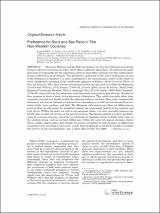Mostrar el registro sencillo del ítem
Preference for sons and sex ratio in two non-western societies
| dc.contributor.author | Crognier, E | |
| dc.contributor.author | Baali, A | |
| dc.contributor.author | Hilali, MK | |
| dc.contributor.author | Villena, M | |
| dc.contributor.author | Vargas, E | |
| dc.date.accessioned | 2021-07-15T14:09:21Z | |
| dc.date.available | 2021-07-15T14:09:21Z | |
| dc.date.issued | 2006 | |
| dc.identifier.uri | http://repositorio.umsa.bo/xmlui/handle/123456789/25619 | |
| dc.description.abstract | ABSTRACT Moroccan Berbers and the Bolivian Aymara are two unrelated peasant groups living in adverse environments with a still rather traditional agriculture. Precarious life conditions may be responsible for the importance given to male labor and hence for the cultural preference conferred on male descent. This preference, expressed in the social valorization of sons to the detriment of daughters, is more emphasized if the socioeconomic status of the family is lower. Interpreted according to the cost/benefit approach of Fisher ([1958] Genetical Thoery of Natural Selection, New York: Dover) of variations in the sex ratio and to its later developments (Trivers and Willard [1973] Science 179:90–91; Trivers [1985] Social Evolution, Menlo Park: Benjamin/Cummings; Hewlett [1991] J. Anthropol. Res. 47:1–37; Smith [1993] Ethol. Sociobiol. 14:39–44), these cultural characteristics could determine that parents bias the care allocated to their progeny in favor of sons, to the detriment of daughters. This could eventually affect their respective survival and finally modify the offspring tertiary sex ratio. This study compares differences in survival as indicators of parental care according to a child’s sex and across three economic strata: poor, medium, and high. The Moroccan data express no other sex differences in survival than an advantage for daughters during the preweaning period in the medium and high strata. Within the same sex and across economic strata, a greater mortality between age 10–20 years is observed for boys of the poorest stratum. The Aymara data do not show sex differences by economic stratum, except for an advantage to daughters between birth and 5 years in the medium group, and no survival differences within the same sex across economic strata. These results suggest either that despite the social valorization of male progeny no differences in parental care according to sex occur, or that their magnitude is not great enough to contrast the survival of sons and daughters. | es_ES |
| dc.language.iso | en | es_ES |
| dc.publisher | American Journal of Human Biology | es_ES |
| dc.subject | TEORÍA GENÉTICA | es_ES |
| dc.subject | SELECCIÓN NATURAL | es_ES |
| dc.subject | PREFERENCIA POR HIJOS | es_ES |
| dc.title | Preference for sons and sex ratio in two non-western societies | es_ES |
| dc.type | Article | es_ES |

